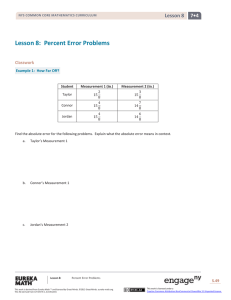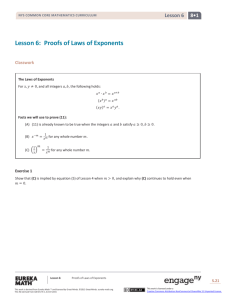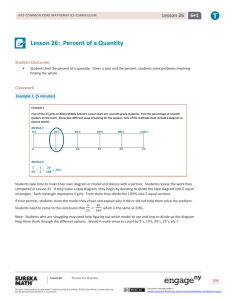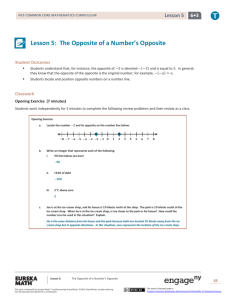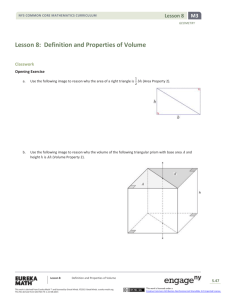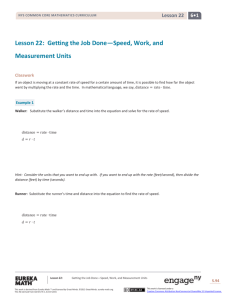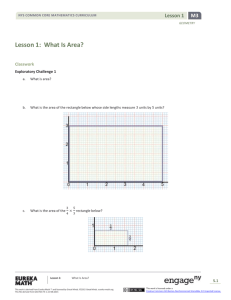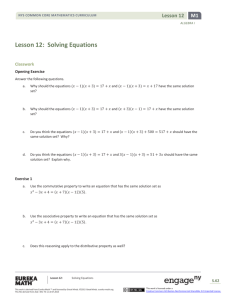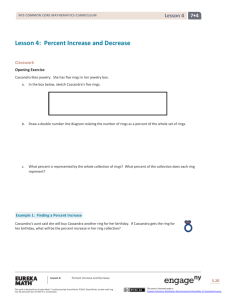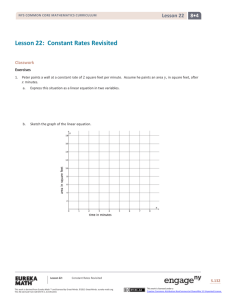Another Computational Method of Solving a Linear
advertisement
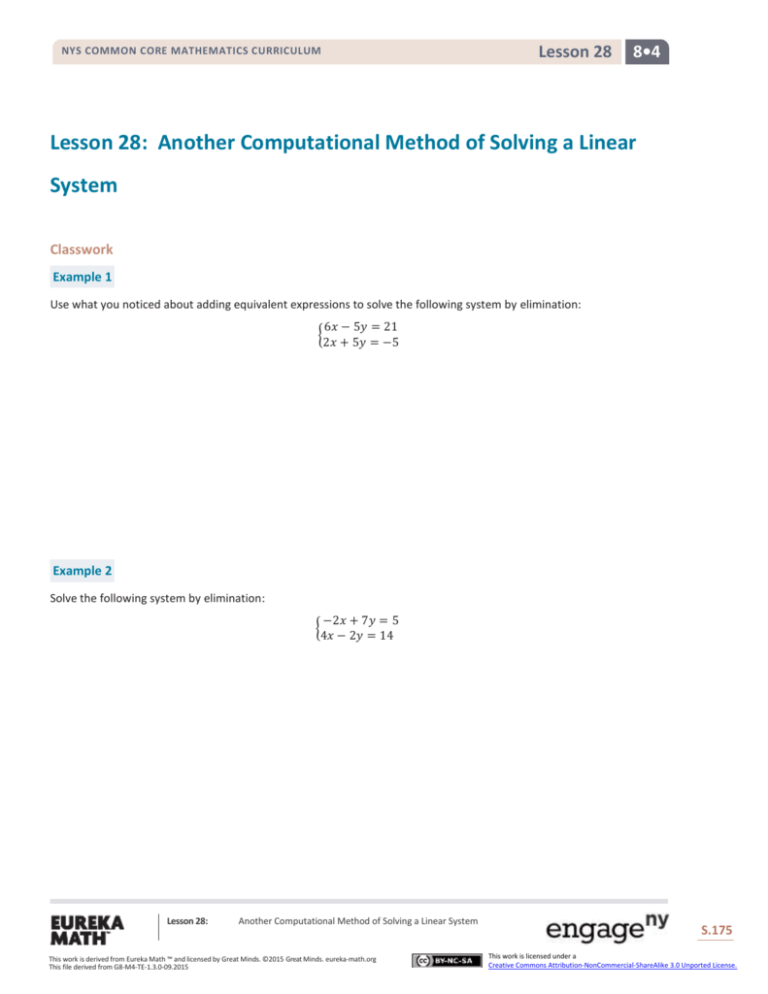
NYS COMMON CORE MATHEMATICS CURRICULUM
Lesson 28
8•4
Lesson 28: Another Computational Method of Solving a Linear
System
Classwork
Example 1
Use what you noticed about adding equivalent expressions to solve the following system by elimination:
6𝑥 − 5𝑦 = 21
{
2𝑥 + 5𝑦 = −5
Example 2
Solve the following system by elimination:
−2𝑥 + 7𝑦 = 5
{
4𝑥 − 2𝑦 = 14
Lesson 28:
Another Computational Method of Solving a Linear System
This work is derived from Eureka Math ™ and licensed by Great Minds. ©2015 Great Minds. eureka-math.org
This file derived from G8-M4-TE-1.3.0-09.2015
S.175
This work is licensed under a
Creative Commons Attribution-NonCommercial-ShareAlike 3.0 Unported License.
NYS COMMON CORE MATHEMATICS CURRICULUM
Lesson 28
8•4
Example 3
Solve the following system by elimination:
7𝑥 − 5𝑦 = −2
{
3𝑥 − 3𝑦 = 7
Exercises
Each of the following systems has a solution. Determine the solution to the system by eliminating one of the variables.
Verify the solution using the graph of the system.
1.
6𝑥 − 7𝑦 = −10
{
3𝑥 + 7𝑦 = −8
Lesson 28:
Another Computational Method of Solving a Linear System
This work is derived from Eureka Math ™ and licensed by Great Minds. ©2015 Great Minds. eureka-math.org
This file derived from G8-M4-TE-1.3.0-09.2015
S.176
This work is licensed under a
Creative Commons Attribution-NonCommercial-ShareAlike 3.0 Unported License.
NYS COMMON CORE MATHEMATICS CURRICULUM
2.
𝑥 − 4𝑦 = 7
{
5𝑥 + 9𝑦 = 6
3.
2𝑥 − 3𝑦 = −5
{
3𝑥 + 5𝑦 = 1
Lesson 28:
Another Computational Method of Solving a Linear System
This work is derived from Eureka Math ™ and licensed by Great Minds. ©2015 Great Minds. eureka-math.org
This file derived from G8-M4-TE-1.3.0-09.2015
Lesson 28
8•4
S.177
This work is licensed under a
Creative Commons Attribution-NonCommercial-ShareAlike 3.0 Unported License.
Lesson 28
NYS COMMON CORE MATHEMATICS CURRICULUM
8•4
Lesson Summary
Systems of linear equations can be solved by eliminating one of the variables from the system. One way to
eliminate a variable is by setting both equations equal to the same variable and then writing the expressions equal
to one another.
𝑦 = 3𝑥 − 4
Example: Solve the system {
.
𝑦 = 2𝑥 + 1
Since the expressions 3𝑥 − 4 and 2𝑥 + 1 are both equal to 𝑦, they can be set equal to each other and the new
equation can be solved for 𝑥:
3𝑥 − 4 = 2𝑥 + 1
Another way to eliminate a variable is by multiplying each term of an equation by the same constant to make an
equivalent equation. Then, use the equivalent equation to eliminate one of the variables and solve the system.
2𝑥 + 𝑦 = 8
Example: Solve the system {
.
𝑥 + 𝑦 = 10
Multiply the second equation by −2 to eliminate the 𝑥.
−2(𝑥 + 𝑦 = 10)
−2𝑥 − 2𝑦 = −20
Now we have the system {
2𝑥 + 𝑦 = 8
.
−2𝑥 − 2𝑦 = −20
When the equations are added together, the 𝑥 is eliminated.
2𝑥 + 𝑦 − 2𝑥 − 2𝑦 = 8 + (−20)
𝑦 − 2𝑦 = 8 + (−20)
Once a solution has been found, verify the solution graphically or by substitution.
Problem Set
Determine the solution, if it exists, for each system of linear equations. Verify your solution on the coordinate plane.
1
1.
𝑥+5=𝑦
{2
2𝑥 + 𝑦 = 1
2.
9𝑥 + 2𝑦 = 9
{
−3𝑥 + 𝑦 = 2
3.
𝑦 = 2𝑥 − 2
{
2𝑦 = 4𝑥 − 4
Lesson 28:
Another Computational Method of Solving a Linear System
This work is derived from Eureka Math ™ and licensed by Great Minds. ©2015 Great Minds. eureka-math.org
This file derived from G8-M4-TE-1.3.0-09.2015
S.178
This work is licensed under a
Creative Commons Attribution-NonCommercial-ShareAlike 3.0 Unported License.
NYS COMMON CORE MATHEMATICS CURRICULUM
4.
8𝑥 + 5𝑦 = 19
{
−8𝑥 + 𝑦 = −1
5.
𝑥+3=𝑦
{
3𝑥 + 4𝑦 = 7
6.
𝑦 = 3𝑥 + 2
{
4𝑦 = 12 + 12𝑥
7.
4𝑥 − 3𝑦 = 16
{
−2𝑥 + 4𝑦 = −2
8.
2𝑥 + 2𝑦 = 4
{
12 − 3𝑥 = 3𝑦
9.
𝑦 = −2𝑥 + 6
{
3𝑦 = 𝑥 − 3
Lesson 28
8•4
𝑦 = 5𝑥 − 1
10. {
10𝑥 = 2𝑦 + 2
3𝑥 − 5𝑦 = 17
11. {
6𝑥 + 5𝑦 = 10
12. {
4
3
𝑦 = 𝑥−9
𝑦 =𝑥+3
4𝑥 − 7𝑦 = 11
13. {
𝑥 + 2𝑦 = 10
21𝑥 + 14𝑦 = 7
14. {
12𝑥 + 8𝑦 = 16
Lesson 28:
Another Computational Method of Solving a Linear System
This work is derived from Eureka Math ™ and licensed by Great Minds. ©2015 Great Minds. eureka-math.org
This file derived from G8-M4-TE-1.3.0-09.2015
S.179
This work is licensed under a
Creative Commons Attribution-NonCommercial-ShareAlike 3.0 Unported License.




